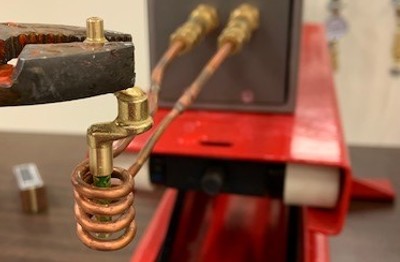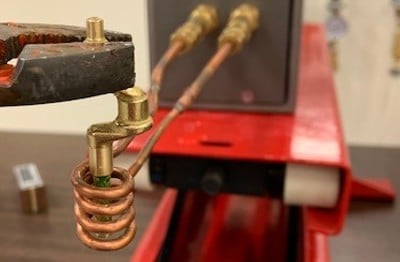Curing Material on an Aluminum Mandrel
Objective Heat a customer supplied aluminum cylinder to 80-120°C for a material curing application. More application notes
Processes
Processes: More
Processes: More

Industries:
Industries: More
Industries: More
Industries: More

Products:
Products: More
Services:
Services: More

Learn:
Learn: More
About:

1 min read
Brett Daly
1/31/19 3:50 PM


An organization had been using a torch for this metal-to-plastic insertion application involving heating a brass shaft, however it required multiple torches to meet their growing throughput requirements. Consequently, they wanted to see if induction heating could offer them a more efficient solution. They turned to THE LAB at Ambrell and took advantage of complimentary application testing.
THE LAB determined that an Ambrell EASYHEATTM 2.4 kW, 150-400 kHz induction heating system would be the right solution for their process requirements. Temperature indicating paint was applied to the part, which dissolves when the part reaches the target temperature. It took 2.5 seconds to heat the part to temperature with the EASYHEAT system set to a frequency of 325 kHz. This result achieved the client's requirements.
Induction heating offers several benefits when compared to torch heating. Speed can be one factor, in this case one induction heating system did the job that several torches were doing. Additionally, precision and repeatability are considerable benefits, as induction delivers consistent results every time while a torch is dependent on the operator. Finally, eliminating an open flame in the work environment enhances safety in the workplace while also introducing less heat into the work environment.
To read other metal-to-plastic application notes from THE LAB at Ambrell, visit our metal-to-plastic insertion applications page.

Objective Heat a customer supplied aluminum cylinder to 80-120°C for a material curing application. More application notes

In today’s manufacturing landscape, efficiency, precision, and sustainability are critical. Induction heating—a process that uses electromagnetic...

When it comes to many manufacturing processes, including this forging application, precision and efficiency are critical. Traditional heating methods...